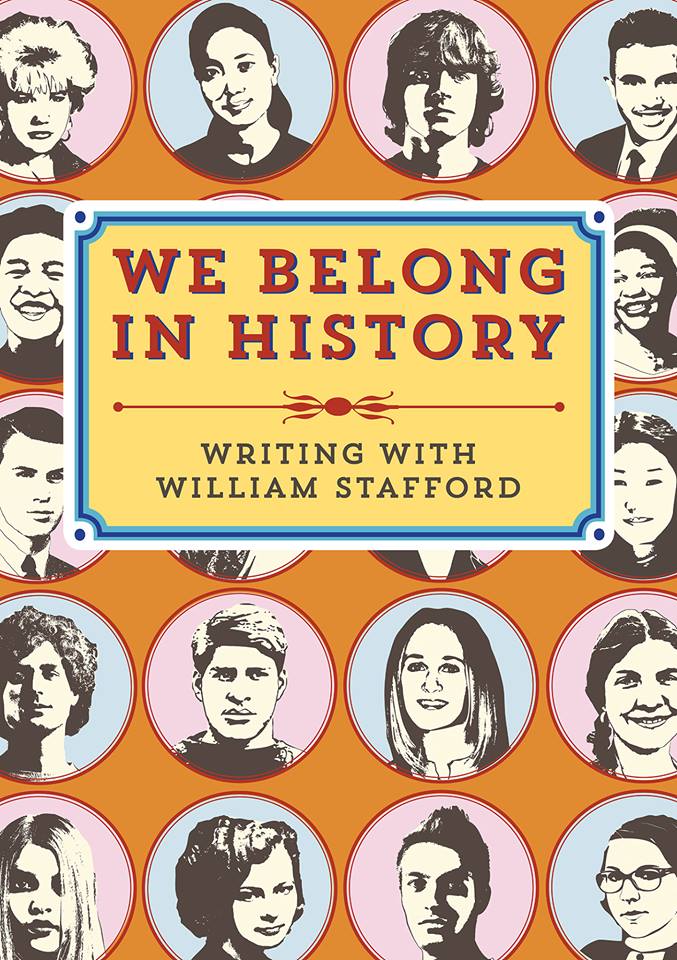Adam Salazar, the former marketing team lead with Ooligan Press, is finishing up his time in the publishing program this term; a man of many talents, he designed the interior for We Belong In History. We welcomed the chance to sit down with him before he graduates, and took the opportunity to chat with him about his design process.
What makes We Belong In History special?
I think the most exciting aspect of We Belong In History is the marriage between old work (Stafford) and new work (students). With this book you see how Stafford’s legacy is continued in a new generation. You see the power of Stafford’s work in his own poetry we’ve published, sure. But you also get to see the depth of feeling that his work engenders in these students’ work.
Why did you decide to take on the task of designing the interior?
I had really started to enjoy doing design work in my classes. Every opportunity I had to use inDesign I jumped at. When the call for an interior designer for We Belong In History came up, I thought it was the perfect opportunity to really test and stretch myself. It was basically the only Ooligan task I had over the summer, and I really enjoyed being able to dive into the work, come up with ideas, and test them out. I also really wanted to create something that I could really take pride in. You only get a handful of opportunities to undertake tasks of this magnitude that require so much of your effort and creativity.
What were some of the challenges you faced during the design process? How did you overcome them?
The biggest challenges of the process were the lesson plans. I really had no experience laying out material of that nature (heads, subheads, bullet points, tables, blank forms), and I went into the process knowing they’d be difficult. When I submitted the first draft of the completed interior, the lesson plan sections were pretty raw, and I knew they’d need heavy revisions, both technically and stylistically. That support came in the form of three people: Lorna Nakell, Riley Kennysmith, and Abbey Gaterud. All three of them pointed me in the right direction, offered suggestions, and helped me out when tasks were out of my technical reach.
Is there any part of the design that you are particularly proud of?
One part that I’m pretty fond of is the circle motif that repeats throughout the book. I was originally inspired by the cover design, done by Lorna. On the cover she has various portraits encased in circles that run horizontally. I thought that this created a delicate and modern effect for the cover, and I was thus determined to echo it in the interior. You see circles repeat in a few places in the interior, most noticeably in the pagination. I have W, B, I, & H encased in tight circles on one page, with the page number residing on the opposite page. Also, there are brief meditations that punctuate each section of the book, and there is a circle motif repeated there as well I thought that this motif wove a subtle thread throughout the book that started with Lorna’s striking cover.

What were some of the most important lessons you learned in the process of designing the interior for We Belong in History?
I learned the power of paragraph styles. When you’re working with lots of different types of text (prose, poetry, lesson plans), it’s really important to keep track of every style you apply to your work. I got really good at organizing my work in inDesign, and it really paid off when it came to making changes and tweaks at the tail end of the project. I also learned that no one piece of a work is more important than the other. As trying as the lesson plan sections were, when they were completed and I stepped back and looked at the entire work as a whole, I couldn’t help but realize how much more striking the poetry and prose sections were made by them.
What recommendations do you have to future PSU publishing students undertaking an interior design, either for prose or poetry? What do you wish you had known before you started?
Do your research, and stay in contact with those around you. Find examples of work similar to the one you’re designing to get ideas on how to style your design. Poetry was something else that I had never really designed before, so I looked at examples from books in my own possession to get ideas about type size, heading styles, and margins. You should always stay in contact with those around you when you’re doing an interior. We’re a teaching press, so it’s foolish not to use the resources at your disposal in order to make the best book possible. I was extremely fortunate that I had more than one person to go to when I encountered trouble or needed guidance. An interior is not a one-person job. When you look at it you’re seeing the hands, ideas, and sweat of more people than just me.

